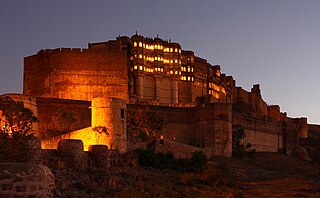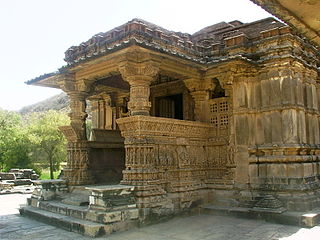Giles Tillotson | |
|---|---|
| Born | July 25, 1960 |
| Academic work | |
| Institutions | School of Oriental and African Studies |
Giles Henry Rupert Tillotson (born 1960) is a writer and lecturer on Indian history and architecture. [1]
Giles Tillotson | |
|---|---|
| Born | July 25, 1960 |
| Academic work | |
| Institutions | School of Oriental and African Studies |
Giles Henry Rupert Tillotson (born 1960) is a writer and lecturer on Indian history and architecture. [1]
He was previously Reader in History of Art and Chair of Art & Archaeology at the School of Oriental and African Studies (SOAS), University of London. From 2011 to 2020 he was Consultant Director at the Maharaja Sawai Man Singh II Museum in the City Palace, Jaipur. He is also Fellow and a former director of the Royal Asiatic Society, London. [1]
He currently lives in India and is Senior Vice President (Museum Exhibitions) at DAG, New Delhi.
His scholarly books include The Rajput Palaces (1987), The Tradition of Indian Architecture (1989), The Artificial Empire (2000), and Building Jaipur (2002, co-authored with Vibhuti Sachdev). His popular writing for general audiences includes his 'Golden Triangle' trilogy - Jaipur Nama (2006), Taj Mahal (2008), and Delhi Darshan (2019) - and the historical novella Return to Bhanupur (2012). He has also edited books on collections, including James Tod's Rajasthan: The Historian and his Collections (2007), A Passionate Eye: Textiles, Paintings and Sculptures from the Bharany Collections (2014), Painting & Photography at the Jaipur Court (2016, with Mrinalini Venkateswaran), and Modern Indian Painting: Jane & Kito de Boer Collection (2019, with Rob Dean).
His major publications include:

Rajasthan is a state in northwestern India. It covers 342,239 square kilometres (132,139 sq mi) or 10.4 per cent of India's total geographical area. It is the largest Indian state by area and the seventh largest by population. It is on India's northwestern side, where it comprises most of the wide and inhospitable Thar Desert and shares a border with the Pakistani provinces of Punjab to the northwest and Sindh to the west, along the Sutlej-Indus River valley. It is bordered by five other Indian states: Punjab to the north; Haryana and Uttar Pradesh to the northeast; Madhya Pradesh to the southeast; and Gujarat to the southwest. Its geographical location is 23°.3' to 30°.12' North latitude and 69°.30' to 78°.17' East longitude, with the Tropic of Cancer passing through its southernmost tip.

Jaipur is the capital and the largest city of the north-western Indian state of Rajasthan. As of 2011, the city has a population of 3.1 million, making it the tenth most populous city in the country. Located 268 km from the national capital New Delhi, Jaipur is also known as the Pink City due to the dominant color scheme of its buildings in old city.

Originating in ancient India, Vastu Shastra is a traditional Hindu system of architecture based on ancient texts that describe principles of design, layout, measurements, ground preparation, space arrangement, and spatial geometry. The designs aim to integrate architecture with nature, the relative functions of various parts of the structure, and ancient beliefs utilising geometric patterns (yantra), symmetry, and directional alignments.

Sawai Jai Singh II, was the 29th Kachwaha Rajput ruler of the Kingdom of Amber, who later founded the fortified city of Jaipur and made it his capital. He became the ruler of Amber at the age of 11, after the untimely death of his father, Mirza Raja Bishan Singh, on 31 December 1699.

Mehrangarh is an historic fort located in Jodhpur, Rajasthan, India. It stands on a hilltop, rising about 122 m (400 ft) above the surrounding plains, and the complex spans 1,200 acres. It was initially built around 1459 by the Rajput ruler of Rathore clan Rao Jodha, though most of the existing structure is from the 17th century built by his successors. The fort has seven gates, which includes main entrance Jai Pol, built by Maharaja Man Singh to commemorate his victories over the Jaipur and Bikaner armies in 1806. The Fattehpol, commemorates victory of Maharaja Ajit Singh over the Mughals.

Chhatri are semi-open, elevated, dome-shaped pavilions used as an element in Indo-Islamic architecture and Indian architecture. They are most commonly square, octagonal, and round.

The Hawa Mahal is a palace in the city of Jaipur, Rajasthan, India. Built from red and pink sandstone, it is on the edge of the City Palace, Jaipur, and extends to the Zenana, or women's chambers.

The Kachhwaha, or Kushwaha is a Rajput clan found primarily in India.

Sawai Madho Singh I was the Kachwaha Rajput ruler of the Kingdom of Jaipur. He was the younger son of Maharaja Sawai Jai Singh II and younger half brother of Sawai Ishwari Singh. He became ruler of Jaipur after his brother Sawai Ishwari Singh died in 1750.

Samode Palace, Samode Haveli and Samode Bagh (Garden) are heritage monuments and structures built by the noble feudatory with the hereditary title of 'Maha Rawal' or 'Maha Saheb’ of the Amber and Jaipur principality in Rajasthan, India. All three have rich history of several hundred years and display a fusion of Mughal and Rajasthani art and architecture. They are now part of the Heritage group of hotels under the flagship name of "Samode" that are run by the hereditary owners of these structures. The Samode Palace is located 40 kilometres (25 mi) north of Jaipur city, the Samode Haveli is close to Jaipur (centrally located within city limits, 6 kilometres (3.7 mi) away from the city railway station) and the Samode Bagh or Garden, 4 kilometres (2.5 mi) from the palace which is also run as a luxury hotel.

The architecture of the Indian state of Rajasthan has usually been a regional variant of the style of Indian architecture prevailing in north India at the time. Rajasthan is especially notable for the forts and palaces of the many Rajput rulers, which are popular tourist attractions.

The history of human settlement in the western Indian state of Rajasthan dates back to about 100,000 years ago. Around 5000 to 2000 BCE many regions of Rajasthan belonged as the site of the Indus Valley Civilization. Kalibangan is the main Indus site of Rajasthan, here fire altars have been discovered, similar to those found at Lothal.

Sir Samuel Swinton Jacob,, known as Sir Swinton Jacob, was a British Army officer and colonial engineer, architect and writer, best known for the numerous Indian public buildings he designed in the Indo-Saracenic style.

The culture of Rajasthan includes many artistic traditions that reflect the ancient Indian way of life. This historical state of India attracts tourists and vacationers with its rich culture, tradition, heritage and monuments.

Rajasthan is one of the most popular tourist destinations in India, for both domestic and international tourists. Rajasthan attracts tourists for its historical forts, palaces, art and culture with its slogan "Padharo Mhare Desh " The capital city, Jaipur, also known as Pink City, is a very popular tourist destination and is a part of the Golden Triangle. The Walled City of Jaipur is only the second Indian city to be recognized as a UNESCO World Heritage Site, after Ahmedabad.

The City Palace, Jaipur is a royal residence and former administrative headquarters of the rulers of the Jaipur State in Jaipur, Rajasthan. Construction started soon after the establishment of the city of Jaipur under the reign of Maharaja Sawai Jai Singh II, who moved his court to Jaipur from Amber, in 1727. Jaipur remained the capital of the kingdom until 1949—when it became the capital of the present-day Indian state of Rajasthan—with the City Palace functioning as the ceremonial and administrative seat of the Maharaja of Jaipur. The construction of the Palace was completed in 1732 and it was also the location of religious and cultural events, as well as a patron of arts, commerce, and industry. It was constructed according to the rules of vastushastra, combining elements of Mughal and Rajput architectural styles. It now houses the Maharaja Sawai Man Singh II Museum, and continues to be the home of the Jaipur royal family. The royal family has around 500 personal servants. The palace complex has several buildings, various courtyards, galleries, restaurants, and offices of the Museum Trust.The MSMS II Museum Trust is headed by chairperson Rajamata Padmini Devi of Jaipur. Princess Diya Kumari runs the Museum Trust, as its secretary and trustee. She also manages The Palace School and Maharaja Sawai Bhawani Singh School in Jaipur. She founded and runs the Princess Diya Kumari Foundation to empower underprivileged and underemployed women of Rajasthan. She is also an entrepreneur. In 2013, she was elected as Member of the Legislative Assembly of Rajasthan from the constituency of Sawai Madhopur.

The Jawahar Kala Kendra (JKK) is a multi-arts center located in the city of Jaipur, India. It was built by the Government of Rajasthan to preserve Rajasthani arts and crafts. The center has eight blocks housing museums, an amphitheater, a closed auditorium, a library, art display rooms, a cafeteria, a small hostel, and an art studio. It also houses two permanent art galleries and three others, and it hosts its yearly theatre festival.

The Jaipur city wall is the city wall encircling the old Jaipur city in Rajasthan state in India.

Manavati Bai, also spelled Manvati Bai,, better known by her title, Jagat Gosain, was the second wife and the empress consort of the fourth Mughal emperor Jahangir and the mother of his successor, Shah Jahan.

Hill Forts of Rajasthan are six forts, spread across Rajasthan state in northern India. They have been clustered as a series and designated as a UNESCO World Heritage Site in 2013. The hill forts series include—Chittor Fort at Chittorgarh, Kumbhalgarh Fort at Rajsamand, Ranthambore Fort at Sawai Madhopur, Gagron Fort at Jhalawar, Amer Fort at Jaipur and Jaisalmer Fort at Jaisalmer.